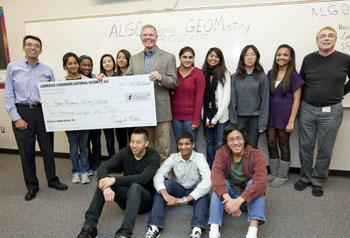LLNS gift helps prime math problem-solvers for the future
 (Download Image)
Co-teachers Gregory Duran (left) and Pierre Bierre (right) along with students from Dougherty Valley High School in San Ramon accept a gift of $10,000 from LLNS representative Paul Rosenkoetter, in support of the pilot algorithmic geometry class.
(Download Image)
Co-teachers Gregory Duran (left) and Pierre Bierre (right) along with students from Dougherty Valley High School in San Ramon accept a gift of $10,000 from LLNS representative Paul Rosenkoetter, in support of the pilot algorithmic geometry class.
The decades-old approach to teaching math in U.S. high schools doesn't add up when it comes to the technology in use today - applications such as Google earth, 3D animation, GPS and robotics. How can educators bring U.S. students up to date to develop the skill-set needed for mathematical problem-solving in the 21st century?
Partnering with a local courseware developer and a public high school, Lawrence Livermore National Security, LLC (LLNS), the contract manager for Lawrence Livermore National Laboratory, is helping prepare local students by contributing $10,000 toward a one-of-a-kind pilot course in algorithmic geometry offered at Dougherty Valley High School in San Ramon. The course is geared toward juniors and seniors with strong math skills and an interest in high-tech careers.
Unlike traditional methods of teaching math where students are instructed to solve arbitrary math equations with little context or connection to applications, algorithmic geometry immerses students in "real world" challenges requiring creative application of math skills to find a solution - - for example, designing a computer algorithm to control a robotic arm.
The paradigm change does not stop there. In 21st century applications, math know-how is brought to life by writing software. Starting from a paper and pencil problem, each student maps out a set of computational steps on paper that can solve the problem. Students also learn how to translate their algorithm design into Java code, and then test-run it using computer graphics. At this point, the problem solution is captured in an automated form ready to be applied over and over again while solving harder problems.
Within this new education paradigm, math and computer science are blended seamlessly, enabling the problem solver to piggyback solutions over many levels, rapidly surpassing the limitations of paper and pencil math. Using this method, older teens can advance to unraveling the mystery of a GPS positioning device before entering college.
"LLNS has always supported science, technology, engineering and math (STEM) education," said George Miller, LLNS President and Lawrence Livermore National Laboratory Director.
"Algorithmic geometry presents a unique opportunity to introduce educators to a math instruction that will better prepare their students for the global high-tech agenda of the future."
Developed by biotech computer scientist Pierre Bierre and his team at Spatial Thoughtware in Pleasanton, the course seeks to disseminate the way geometric problem-solving is practiced in high-tech, and update standardized math content offered in U.S. schools for the computing revolution.
Pointing to a rapid shift in the nation's skill base needs, Bierre says, "The Bureau of Labor Statistics estimates that 71 percent of jobs in science, technology, engineering and math by the year 2018 will require an understanding of computing and software."
The course was begun in the San Ramon Valley Unified School District through the initiative of Gregory Duran, a math teacher at Dougherty Valley High, and Stan Hitomi, principal of Alamo School and coordinator of Education Services. Duran and Bierre are co-instructing the pilot course.
Duran who spent 17 years in the high technology industry before becoming a math teacher states, "Dougherty Valley High School (DVHS) has a large number of students and parents who value a strong math and science education.
"Algorithmic geometry teaches students how to solve complex problems using mathematics and then bring the solution to life using 21st century computational tools. DVHS is the perfect school to pilot this course."




